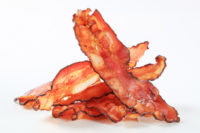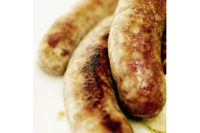Well, it was bound to happen — a TV show devoted to bacon. “United States of Bacon” premiered this winter on the Destination America channel, owned by Discovery. The show follows Chef Todd Fisher as he searches for the best bacon dishes in America.
“It’s bacon’s time now.”Patrick Fleming, National Pork Board |
It’s a bacon nation, and we just live in it. Bacon continues its dominance over the American people with new flavors and applications, such as bacon gumballs, bacon-wrapped hot dogs, bacon chocolate bar and bacon mayonnaise — to name a few.
Is there an end in sight? Not likely.
“Consumers’ love affair with bacon has been a fairly sustained trend,” says Patrick Fleming, director of retail marketing, National Pork Board, based in Des Moines, Iowa. “Everyone wonders when it will slow down. But bacon is still trendy and a popular choice. It’s bacon’s time now.”
The numbers bear this out. According to IRI, a Chicago-based market-research firm, bacon dollar sales at retail increased 2.5 percent to $3.7 billion, and unit sales improved 0.66 percent to 882.1 million pounds, as of June 16, 2013.
These increases came in spite of last year’s projected “aporkalypse.”
Last fall, the media briefly warned of pork and bacon shortages after Great Britain’s National Pig Association announced that world shortages were possible due to smaller herds and higher prices. The truth: The world saw only slightly higher prices and no widespread barren bacon shelves at supermarkets.
The average price of a package of bacon did increase 8 cents to $4.19, reported IRI.
But by the end of June, pork demand at the wholesale level remained strong. AgStar Financial Services reported that belly primal value was $58.07/head compared to $39.04/head a year ago.
Last year’s corn supply is becoming tight (due to ethanol demands and feed for increased chicken production) for pig herds, which can affect bacon’s final price tag.
“Higher prices are always an issue, but sales are still strong,” notes Fleming. “People want more flavor, and they are willing to pay for it.”
Despite higher prices, it doesn’t appear that operators are pulling bacon from their menus. Rather, to offset these costs, some operators may now be charging extra for bacon usage as an ingredient, such as an extra $1.00 for adding bacon to a burger.
“Not only does this help operators offset costs, it also is an excellent way for operators to improve margins,” says Joe Pawlak, vice president at Technomic Inc., a Chicago restaurant- and food-research firm. “Other operators are simply being more conscious about portion control when using bacon in menu applications.”
Beyond the frying pan
Foodservice operators certainly aren’t abandoning bacon and still gain more from having it on their menu than not.
“Currently 69 percent of all bacon sold in the U.S. is through foodservice outlets,” says Drew Lericos, senior brand manager, Farmland Foods Inc., based in Kansas City, Mo. “Foodservice bacon sales have posted a 3 to 4 percent annual growth rate since 2007, which is expected to continue through 2013 and beyond.
Within foodservice, over 67 percent of all restaurants include bacon on their menus.”
Breakfast is still when most bacon is consumed, but it is transitioning to multiple dayparts such as sandwiches, wraps and hand-held items, notes Fleming.
Indeed, according to Chicago-based Mintel International Group’s September 2012 “Breakfast Foods – US” report, the breakfast category is still driven by breakfast meats and sweet breakfast breads and pastries, due to their continued focus on health, indulgence and taste. Yet bacon, obviously, isn’t just for breakfast anymore. In fact, consumers dining out can find it in virtually every meal and every meal segment.
“Demand for bacon within foodservice is at its highest level,” says Pawlak. “Bacon is extremely versatile; it can be used as a side dish, ingredient in other main dish items, a sandwich topping, a flavor enhancer in other foods, and even used in desserts today.”
Consumers are more and more interested in the various flavors and varieties of bacon offered, he says, including hickory, pepper, maple, applewood and even jalapeno.
“Bacon itself has become much more diverse in flavor profiles, which fits very well with consumer demand for unique products,” says Pawlak.
Indeed, bacon is the meat condiment of choice for consumers. And quick-serve restaurants (QSRs) are developing thicker, better-quality options, such as those used in Wendy’s applewood smoked line and McDonald’s new Quarter Pounder line, says Fleming.
This summer, Carl’s Jr. and Hardee’s took the manly image of bacon one step further with its Super Bacon Cheeseburgers, which feature six full strips of bacon (a bacon nest), and are advertised in connection with the “Man of Steel” movie and YouTube’s “Epic Meal Time” show. The Super Bacon Thickburger can also be ordered “epic,” adding an extra bacon nest and cranking the total bacon count up to 12 strips.
“The Super Bacon Cheeseburgers have proven, once again, that it’s difficult to overestimate America’s love affair with bacon,” says Brad Haley, chief marketing officer for Hardee’s, St. Louis, Mo.
According to Haley, “the menu development strategy at Hardee’s and Carl’s Jr. boils down to identifying premium-quality burgers normally only found in casual-dining restaurants and making them available — usually for the very first time — to fast-food consumers.”
Wendy’s also is bringing the taste of the neighborhood pub to its customers. This summer, it is offering Pretzel Bacon Cheeseburgers for a limited time.
“When we previewed the Pretzel Bacon Cheeseburger in January, it became one of our best-tested promotional sandwiches in recent history,” says Denny Lynch, senior vice president of communications, Wendy’s, Dublin, Ohio. “We’re marrying three iconic American favorites: soft pretzel, cheeseburger and bacon.”
Wendy’s has carried bacon on its menu since the 1980s, as an add-on to all of its items, but the fast-food outlet received a lot of attention four years ago when it retooled its bacon selection to thicker, smokier cuts.
Consumers responded, and today one only needs to look at the success of its Baconator burger, which continues to perform well, boasting six strips of bacon on a half pound of beef.
“Bacon is a core menu item for us,” says Lynch. “And we will continue to search for new culinary trends.”
Making it sizzle
Bacon is one of the fastest-growing categories in the meat case, with 2012 retail sales up more than 3 percent, says Leigh Meyers, brand manager, Oscar Mayer/Kraft Foods, based in Madison, Wis.
“Demand is strong, which we attribute to people’s ongoing love affair with bacon — its taste, its status as an affordable indulgence, and its power to transform any meal into a special occasion that brings people together,” she says.
Foodservice is definitely influencing the types of bacon that consumers buy and request at retail. Not only are consumers looking for thicker cuts now, but they want smoke varieties such as applewood and cherrywood.
“When consumers go out to eat and they can get an applewood smoked bacon, they want to purchase this flavor for their own homes and breakfast occasions,” says Terrill Bacon, product manager, Hormel Black Label bacon, Hormel Foods, based in Austin, Minn. “Consumers will eat a specific variety in a restaurant, there will be a brief lag time, and then this smoke variety will show up on the shelves in retail so consumers can share it with their family on weekend breakfast occasions.”
Within the next year, Hormel’s Black Label brand will be introducing a super-premium line of items within the category that are a thicker cut and a different packaging format using different smoke applications.
“Developments in the category were based on today’s consumers’ needs and wants, which are finding convenience without sacrificing flavor and quality,” says Bacon. “By offering a variety of options and flavors in our Hormel bacon line up, we are providing options to fit into all lifestyles, even those who don’t have time to cook bacon (by offering a fully cooked option).”
Although bacon is known as an indulgence, some shoppers want to eat their bacon and not feel guilty about it afterward.
“Natural-product volume increased over 47 percent in the latest 52 weeks and flavored products [excluding hickory smoked] increased 9.4 percent,” says Lericos. “In addition, there was growth in ‘better-for-you’ bacon varieties, including less fat, lower sodium and a combination of the two.”
Meyers agrees that there is more demand for bacon products with simple ingredients and no artificial preservatives.
“We also saw very high demand for turkey bacon, … as more consumers seek out better-for-you options that deliver the same great taste of pork bacon,” says Meyers, who further notes that the stack-pack segment with thicker cuts is growing as well.
Wrapped in convenience
Changes are being made to bacon’s packaging to make it more customer friendly, such as smaller packages, pre-cooked bacon, zipper-close and resealable packs, says Fleming. Twelve-ounce packaging has also improved 4.9 percent over the prior year, outpacing category growth, say Lericos.
“This is likely a response to higher prices and consumers trading down to a smaller package at a lower unit cost,” he explains. New packaging innovations are consistently under development, including enhanced convenience and material source reduction options.
“While volume remains low for pre-cooked bacon, success with pre-cooked breakfast sausage shows that once consumers learn more about this convenient option, they are likely to embrace it,” says Lericos.
Indeed, consumers’ love affair with bacon is here to stay — and inspire future changes.
“We see the consumer pushing in different ways in regards to how they use bacon,” says Bacon. “We continue to see bacon show up in places we haven’t seen before — such as snack applications, bacon-weave taco shells and more. Consumers continue to push manufacturers, and CPG companies to deliver bacon in a fun, new forms.”








